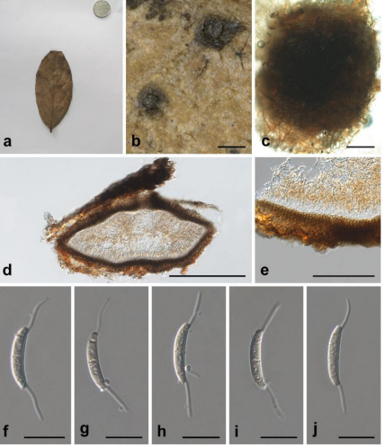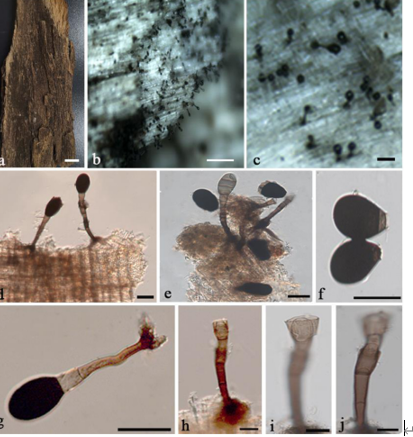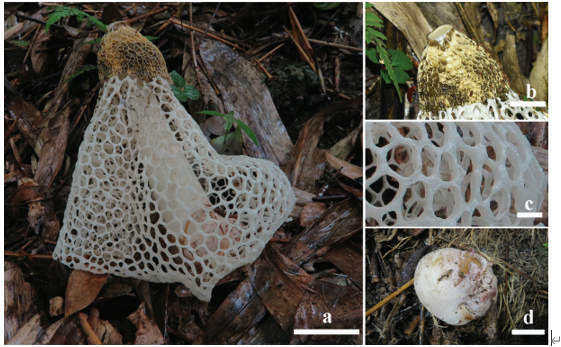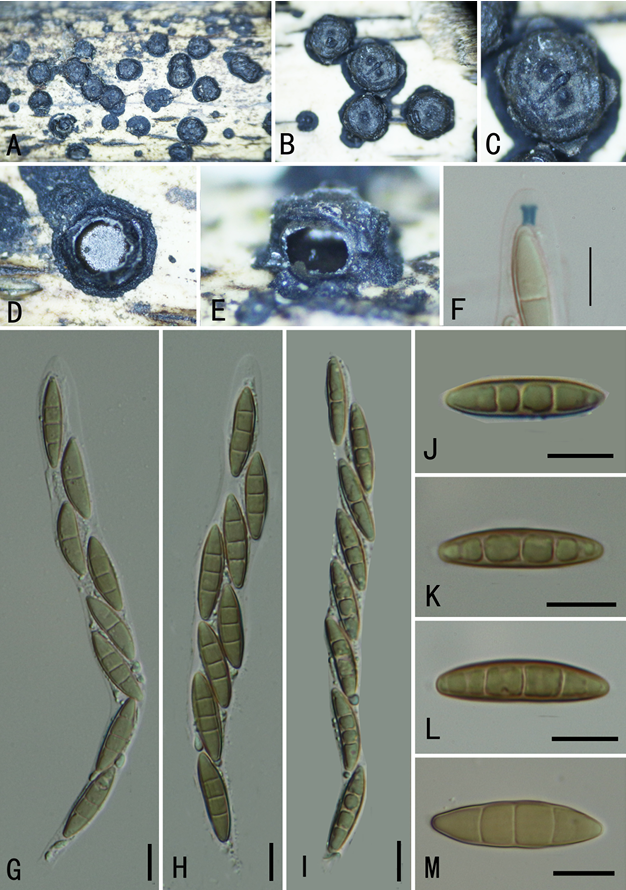Parvosmorbus eucalypti W. Wang & S.F. Chen 2020
MycoBank MB832456
Holotype: China, GuangDong Province, ZhanJiang Region, MaZhang District, HuGuang town (N21°9'45.020" E110°17'19.430"), from the stem bark of E. urophylla × E. grandis hybrid genotype, 2 Oct. 2013, S. Chen & G. Li, CSFF2047 (holotype HMAS290462, ex-type culture CSF2061 =CGMCC3.19512).
Morphological description
No ascostromata were observed on the Eucalyptus bark collected from the plantations or on the inoculated Eucalyptus branch tissue. Conidiomata pycnidial, superficial to slightly immersed, solitary, conical to globose, without necks, bright yellow when young, fuscous black when mature. Conidiomatal base 140–770 µm (av. 357 µm) high above the level of bark and 104–471 µm (av. 242 µm) wide. Conidiomatal locules unilocular, locules 59–276 µm (av. 174 µm) diam. Stromatic tissue textura porrecta. Conidiophores hyaline, branched irregularly at the base or above into cylindrical cells, with or without separating septa, (5.5–)11.5–12.5(–24.5) µm (av. 12 µm) long. Conidiogenous cells phialidic, cylindrical with or without attenuated apices, (1–)2(–2.5) µm (av. 1.8 µm) wide. Paraphyses or cylindrical sterile cells absent. Conidia hyaline, aseptate, fusoid, occasionally allantoid, exuded through opening at stromatal surface as brown to orange droplets, (3–)4(–4.5) × (1–)1.5 (–2)
µm (av. 3.9 × 1.4 µm).
Culture characteristics — Colonies on MEA fluffy with an uneven margin, white when young, turning yellowish white after 10 d. Colony reverse white to yellowish white. Optimal growth temperature 30 °C, no growth at 5 °C. After 7 d, the colonies at 10 °C, 15 °C, 20 °C, 25 °C, 30 °C, and 35 °C had reached 9.7, 12, 29, 44, 48, and 18 mm, respectively.
Substrate — Bark of E. urophylla × E. grandis hybrid genotype and E. urophylla hybrid genotype.
Habitat: From the stem bark of E. urophylla × E. grandis hybrid genotype.
Distribution: In GuangDong Province, China.
GenBank Accession: ITS: MN258788; tub2: MN258802 ; tub1: MN258816; tef1: MN258830 ; LSU: MN258844
Notes: Parvosmorbus eucalypti is morphologically most similar to Corticimorbus sinomyrti. These two species could be distinguished by growth characteristics in culture, with the optimal growth temperatures of Par. eucalypti and Cor. Sinomyrti being 30 °C and 25 °C, respectively (Chen et al. 2016).
Reference: W. Wang[1],2, G.Q. Li1, Q.L. Liu1 et al.

Asexual sporocarps of Parvosmorbus eucalypti. a. Black conidiomata on the bark; b– c. longitudinal section through the conidioma showing unilocular stroma; d. textura porrecta stromatic tissue of the conidioma; e–f. aseptate, cylindrical conidiophores and cylindrical conidiogenous cells; g. fusoid to oval, aseptate conidia; h–i. living cultures after growing for 7 d on MEA at 25 °C, (h) front, (i) reverse. — Scale bars: a = 100 µm; b– c = 50 µm; d = 10 µm; e–g =5 µm; h–i = 10 mm.









